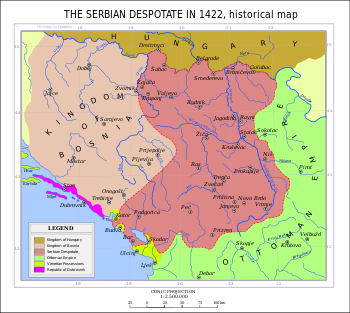الاستبدادية الصربية
الاستبدادية الصربية Serbian Despotate (بالصربية: Српска деспотовина / Srpska despotovina) was a medieval Serbian state in the first half of the 15th century. Although the Battle of Kosovo in 1389 is generally considered the end of medieval Serbia, the Despotate, a successor of the Serbian Empire and Moravian Serbia, survived for another 60 years, experiencing a cultural and political renaissance before it was conquered by the Ottomans in 1459. Before its conquest the Despotate nominally had a suzerain status to the Ottoman Empire, Byzantine Empire and Kingdom of Hungary.[1] After being fully subjugated to the Ottoman Empire in 1459, it continued to exist in exile in the medieval Kingdom of Hungary until the mid-16th century. Pavle Bakić was the last Despot of Serbia to be recognized by both the Ottoman and the Habsburg Monarchy.
Serbian Despotate Српска деспотовина Srpska despotovina | |||||||||||||||||||
|---|---|---|---|---|---|---|---|---|---|---|---|---|---|---|---|---|---|---|---|
| 1402–1459 | |||||||||||||||||||
 الدرع | |||||||||||||||||||
 The Serbian Despotate in 1422 | |||||||||||||||||||
| العاصمة | Beograd Smederevo Bar | ||||||||||||||||||
| اللغات المشتركة | Serbian | ||||||||||||||||||
| الدين | Serbian Orthodox | ||||||||||||||||||
| الحكومة | Vassal monarchy | ||||||||||||||||||
| Despot | |||||||||||||||||||
• 1402–1427 | Stefan Lazarević | ||||||||||||||||||
• 1427–1456 | Đurađ Branković | ||||||||||||||||||
• 1456–1458 | Lazar Branković | ||||||||||||||||||
• 1458–1459 | Stefan Branković | ||||||||||||||||||
• 1459 | Stefan Tomašević | ||||||||||||||||||
| التاريخ | |||||||||||||||||||
• تأسست | February 22 1402 | ||||||||||||||||||
• Conquest | 1459 | ||||||||||||||||||
• انحلت | 1459 | ||||||||||||||||||
| العملة | Serbian dinar | ||||||||||||||||||
| |||||||||||||||||||
. . . . . . . . . . . . . . . . . . . . . . . . . . . . . . . . . . . . . . . . . . . . . . . . . . . . . . . . . . . . . . . . . . . . . . . . . . . . . . . . . . . . . . . . . . . . . . . . . . . . . . . . . . . . . . . . . . . . . . . . . . . . . . . . . . . . . . . . . . . . . . . . . . . . . . . . . . . . . . . . . . . . . . . .
المراجع
External links
- Media related to Serbian Despotate at Wikimedia Commons
- ^ Federico M. Federici & D. Tessicini, Translators, Interpreters, and Cultural Negotiators: Mediating and Communicating Power from the Middle Ages until the Modern Era (Basingstoke 2014), p. 11.